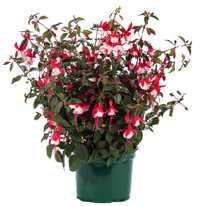1/31/2014
A More Upright, Light-Loving Fuchsia
Randy Uhl

Fuchsia Windchimes Upright is a companion series to the popular Windchimes basket varieties that were bred and selected to be tolerant of warmer growing conditions and higher light levels. The goal was to develop fuchsias that would sustain growth through the summer months. Windchimes Upright possesses a plant form ideal for production in containers versus the trailing form that’s most commonly used in hanging baskets.
This new series replaces Green Fuse’s Diva line with genetics that still showcase the same early flowering, but now include a larger, more double flower and uniform plant habits. With the Windchimes Upright early flowering response, growers have the ability to ship them as a bench run in the early spring, thus allowing an easy additional turn of production space. Windchimes Upright includes five varieties for 2014-15: Neon/White, Red/White, Rose/Purple, White/White and Lilac/Rose.
Crop scheduling and timing
URC to liner production:
Tray Size Rooting Time (wks)
105 5 weeks Soft pinch at 25 to 27 days
72 6 weeks Soft pinch at 27 to 32 days
50 7 weeks Soft pinch at 32 to 35 days
We suggest pinching at the liner stage to establish lateral shoots low on the terminal stem. The above guidelines display weeks to root and a suggested time frame to pinch after rooting. Windchimes won’t require an additional pinch to finish quality plants.
Finishing from liner:
Pot Size Plants per pot (ppp) Finish Time (weeks)
5-in. pot (12 cm) 1 ppp 9 to 11
6-in. pot (15 cm) 1 ppp 11 to 12
6-in. pot (15 cm) 3 ppp 9 to 11
8 to 10-in. pots (20 to 25 cm) 3 to 4 ppp 11 to 13
Irrigation and fertilization
Transplant rooted liners in a well-drained soil mix. The best result occurs when the soil is kept evenly moist, but not constantly saturated. Irrigate early in the day so the foliage can dry before sundown. An optimal soil pH range is 6.0 to 6.5. Fertility requirements for fuchsia are low, so using a prepared Calcium/Magnesium, low ammonium feed at 100 to 200 ppm N is best. A proper EC level for a soilless mix is 0.75 to 1.1 mmos/cm.
Temperature and light levels
Temperatures are best delivered as: Day—70 to 85F (21 to 29C); Night—62 to 65F (17 to 18C).
A negative DIF delivered as part of the temperature regime would prove a positive in controlling stretched internodes. In warm temperature regions like Florida, Windchimes Fuchsia will form a “crown bud” if grown in full sun with no shading. They’ll set buds and bypass the bud with new growth, never developing full color. We believe this is a heat-delay type of response. We suggest Windchimes Upright should be grown with some shading in high-light regions in order to reduce leaf temperatures.
Growth regulators
Under warm temperatures or low light conditions, B-Nine is effective in controlling stretch (1,250 to 2,500 PPM rate). For southern regions with warmer temperatures, products like Sumagic and Topflor are more effective. Use at labeled rates. It’s always best to trial small groups of plants to discover the proper rate for your growing environment. Bonzi drenches at 2 to 3 PPM are highly effective. Be cautious, since multiple applications of Bonzi will reduce flower size.
Disease and insect pests
Aphids, spider mite and whitefly are the most chronic pests to trouble fuchsia. Scouting for these insects and preventative spray programs will keep the plants clean for a quality-finished fuchsia.
Botrytis, Pythium and Rhizoctonia are the diseases of greatest concern. Damage to fuchsia stems will create entry for pathogens. Fuchsias are susceptible to crown rot (Rhizoctonia) if rooted liners are transplanted too deep, covering the crown or if excessive soil is built up around crown. To control Pythium and Phytophthora, a preventative fungicide drench is recommended shortly after transplant (once the root system is actively growing). Maintain good air movement around plants for control of Botrytis or other foliar diseases. Avoid watering plants late in the day creating wet foliage and stems going into the evening.
GT
Randy Uhl is technical sales support for Green Fuse Botanicals in Santa Monica, California and Henry F. Michell, Co. in King of Prussia, Pennsylvania.